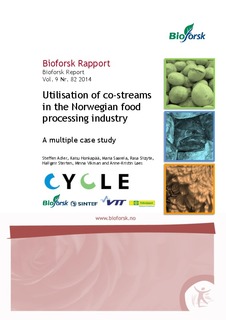| dc.description.abstract | Food losses occur throughout the entire food chain, from primary production via postharvest handling and storage, to food processing, distribution, retailing and consumption. Globally, food losses account for about one third of the total food produced for human consumption. The aim of this report was to map the production and utilisation of co-streams in the food processing industry in Norway and to discuss possibilities for alternative utilisation based on qualitative aspects of the co-streams, and current legislation. This report is produced by work package 3 in the CYCLE project (2013-2016), “Total utilisation of raw materials in the supply chain for food with a bioeconomical perspective”. The CYCLE project aims to improve resource utilisation in the Norwegian food chain by developing sustainable eco-friendly bio-processes and novel technology, in close relationship with food industry partners. Inputs and outputs of organic materials were roughly mapped at selected food processing plants presenting three Norwegian food chains: 1) Vegetables and potatoes; 2) white and pelagic fish; and 3) poultry. Data was collected during plant visits in June 2013, and later checked by staff from the described plants. The report describes the qualitative properties of co-streams, and their current utilisation as feed, fertiliser and as substrate for bioenergy production. We also present relevant regulations in EU and Norway regarding processing and utilisation of co-streams, and discuss alternative utilisation. Altogether, the food processing plants had significant market shares in Norway within fresh potatoes (38%), lettuce (17%), poultry meat (24%) and white and pelagic fish, where export makes up a large proportion. Generally, a large proportion of the raw materials were utilised as food and feed. On average for all plants, 75% of the raw material was utilised in food products, 21% in feed products, 1% in fertiliser and bioenergy production and 3% was deposited in landfill. The plants used in average 8.6 tonnes of process water per tonne of food produced, but the amount varied considerably between the plants. Possible improvements in the utilisation of raw materials and co-streams include a higher degree of utilisation in food products, and developing new or improved feed components from co-streams with increased nutritional value. Due to the current high degree of utilisation in food and feed applications with high economic values, the potential for bioenergy and fertiliser production is limited to certain risk materials. Feed potatoes and vegetables and feathers, bones, blood, viscera and skin from fish or poultry have considerable potential for better utilisation for food or feed. Relevant processing methods for these co-streams are fractionation, hydrolysis, fermentation and drying. | nb_NO |
